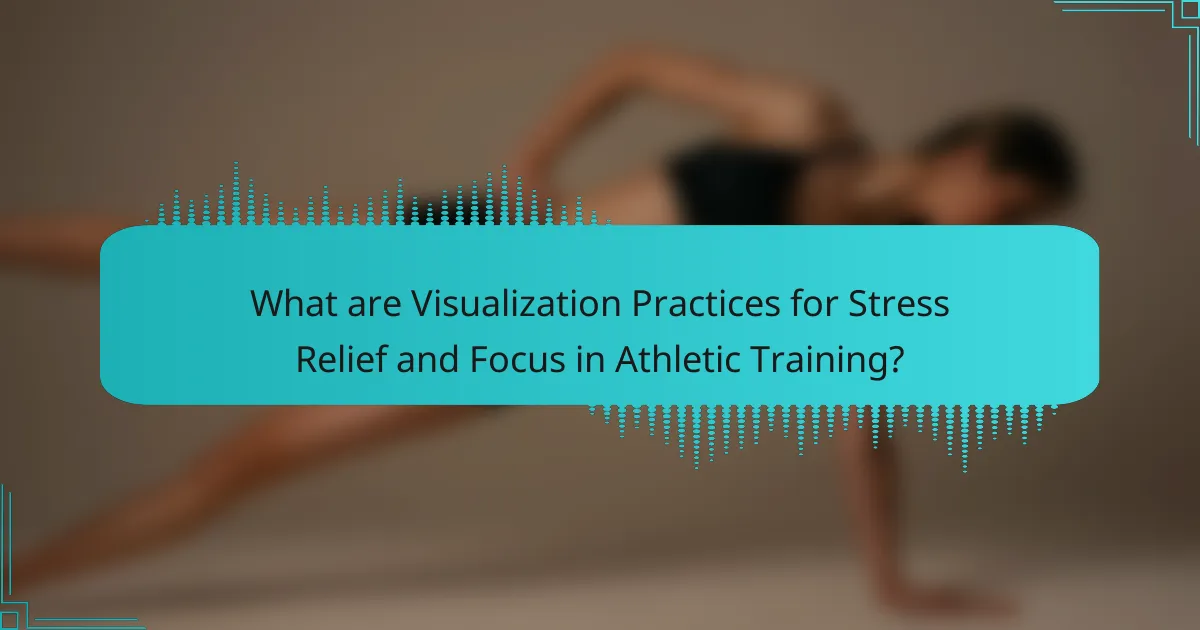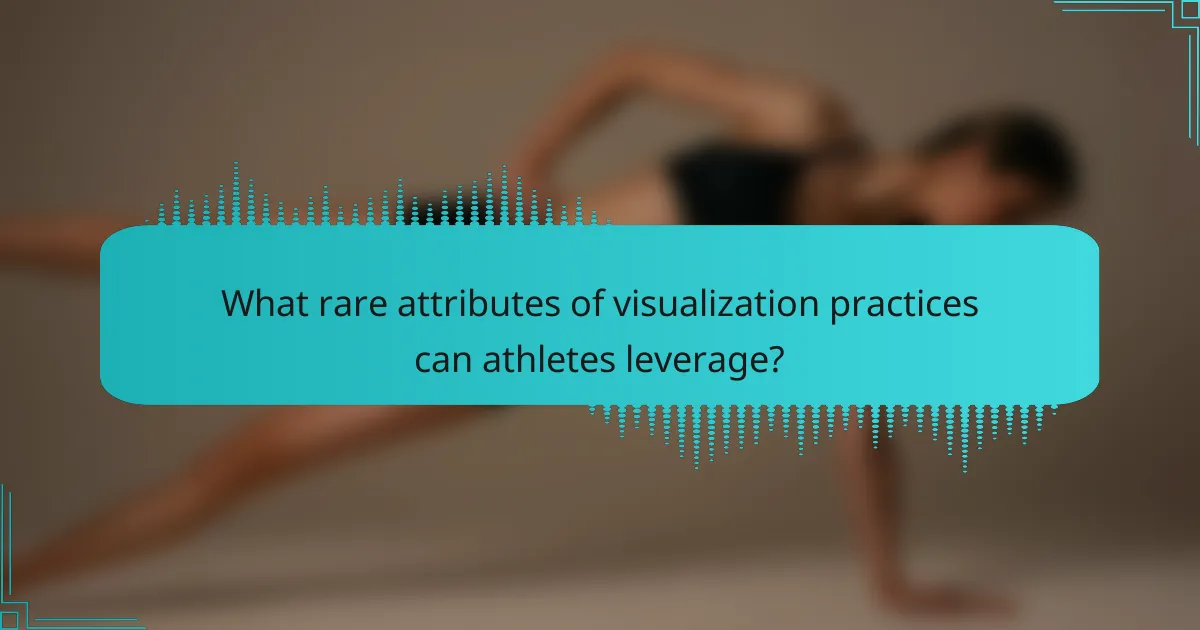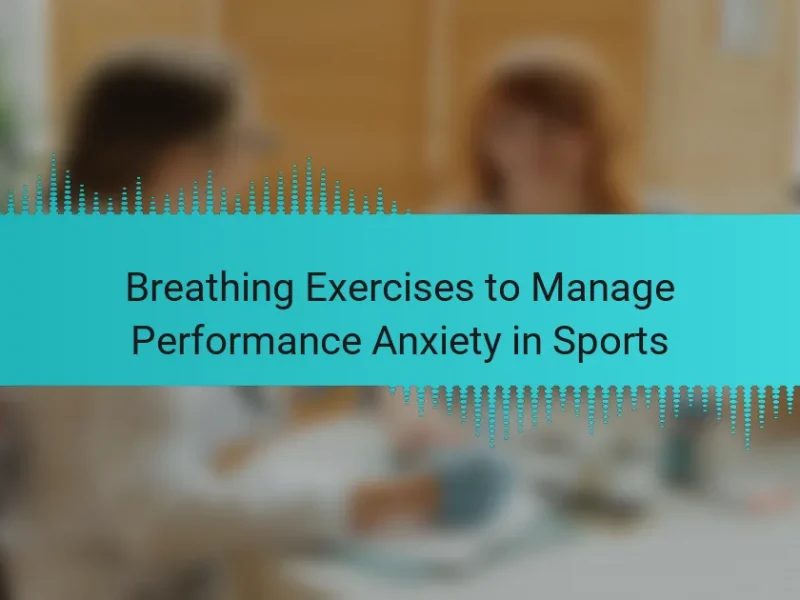Visualization practices enhance stress relief and focus in athletic training. Techniques such as guided imagery and mental rehearsal improve performance by boosting confidence and reducing anxiety. Cultural perceptions shape these practices, influencing their effectiveness and acceptance among athletes. Implementing clear and relevant imagery can lead to better training outcomes and mental resilience.

What are Visualization Practices for Stress Relief and Focus in Athletic Training?
Visualization practices enhance stress relief and focus in athletic training by creating mental imagery of success. Techniques include guided imagery, where athletes visualize themselves performing optimally, and relaxation visualization, which involves imagining peaceful environments to reduce anxiety. Research shows that these practices can improve performance by increasing confidence and concentration. Regular use of visualization can lead to better athletic outcomes, making it a valuable tool for athletes seeking to enhance their training regimen.

What are the universal benefits of visualization techniques in athletic training?
Visualization techniques enhance athletic training by improving focus, reducing stress, and boosting performance. These practices allow athletes to mentally rehearse skills, leading to increased confidence and reduced anxiety during competitions. Research indicates that mental imagery can activate the same brain regions as physical practice, enhancing muscle memory and coordination. Additionally, visualization fosters a positive mindset, helping athletes set and achieve goals effectively. Ultimately, these benefits contribute to overall mental resilience and improved athletic performance.
How does visualization reduce stress during training?
Visualization significantly reduces stress during training by enhancing focus and promoting a sense of control. This mental practice allows athletes to mentally rehearse skills and scenarios, which can lower anxiety levels. Research shows that visualization activates similar brain regions as actual performance, reinforcing confidence and preparedness. Additionally, it provides a unique attribute of creating a personalized mental environment, helping athletes cope with pressure effectively.
In what ways does visualization enhance focus and concentration?
Visualization enhances focus and concentration by creating mental clarity and reducing distractions. It allows athletes to mentally rehearse their performance, which strengthens neural pathways associated with their skills. This practice increases confidence and prepares the mind for physical execution. Additionally, visualization can lower stress levels, promoting a calm and focused state essential for optimal performance.

What unique visualization techniques are effective for athletes?
Visualization techniques such as guided imagery, mental rehearsal, and mindfulness are effective for athletes. Guided imagery involves vividly imagining successful performances, enhancing confidence. Mental rehearsal allows athletes to practice skills mentally, improving muscle memory. Mindfulness promotes focus and stress relief, helping athletes stay present during competition. Each technique contributes uniquely to performance enhancement and mental resilience.
How can guided imagery improve performance?
Guided imagery can enhance performance by improving focus and reducing anxiety. This mental technique allows athletes to visualize successful outcomes, fostering a positive mindset. Research indicates that athletes who engage in visualization practices experience increased confidence and improved concentration during training and competition. By mentally rehearsing techniques and scenarios, they can enhance their physical execution and overall performance.
What role does mental rehearsal play in athletic success?
Mental rehearsal significantly enhances athletic success by improving focus and reducing stress. This visualization practice allows athletes to mentally simulate their performance, which can lead to increased confidence and better execution during actual events. Studies show that consistent mental rehearsal can lead to improved reaction times and skill acquisition. Additionally, athletes who use these techniques often report lower anxiety levels, contributing to overall better performance outcomes.

What rare attributes of visualization practices can athletes leverage?
Athletes can leverage rare attributes of visualization practices like multisensory engagement and temporal distortion. Multisensory engagement enhances mental imagery by incorporating sights, sounds, and feelings, creating a more vivid experience. Temporal distortion allows athletes to manipulate their perception of time during practice, enabling them to focus intensely on specific skills. These unique approaches can lead to improved stress relief and heightened focus in training sessions.
How can visualization be tailored to individual sports?
Visualization can be tailored to individual sports by focusing on specific goals and techniques relevant to each discipline. For example, in basketball, athletes may visualize making free throws, while swimmers might picture their stroke technique.
Each sport has unique attributes that influence visualization practices. Athletes can incorporate elements like competition scenarios, personal performance metrics, and emotional states to enhance focus and reduce stress. Tailoring visualization also involves adjusting the duration and intensity based on the sport’s demands.
Athletes benefit from practicing visualization regularly, aligning it with training schedules to reinforce mental skills. This consistent practice can lead to improved performance and increased confidence during competitions.
What unique psychological effects can arise from visualization?
Visualization can enhance focus and reduce stress in athletic training by creating unique psychological effects. These effects include improved mental clarity, increased motivation, and enhanced emotional regulation. Athletes often report feeling more confident and prepared, as visualization helps them mentally rehearse performance scenarios. This practice can also foster a sense of control and reduce anxiety, allowing athletes to perform at their best under pressure.

How do cultural perceptions influence visualization practices in athletic training?
Cultural perceptions significantly shape visualization practices in athletic training by influencing athletes’ mental approaches. For instance, cultures that emphasize collective success may encourage team-oriented visualization techniques, while individualistic cultures may focus on personal goals.
Moreover, cultural attitudes towards mental training can impact the acceptance and effectiveness of visualization. In cultures that prioritize mental resilience, athletes might integrate visualization as a core practice, enhancing stress relief and focus. Conversely, cultures skeptical of mental training may see less engagement with these techniques, limiting their potential benefits.
Additionally, unique cultural symbols and narratives can enrich visualization practices, allowing athletes to draw from familiar contexts. This personalization enhances the emotional connection to the practice, making it more effective in stress management and performance enhancement.
What are the regional variations in visualization techniques among athletes?
Regional variations in visualization techniques among athletes influence their effectiveness in stress relief and focus. For instance, athletes in Eastern cultures often emphasize mindfulness and meditation, integrating these practices into their visualization techniques. In contrast, Western athletes may focus more on goal-oriented visualization, emphasizing performance outcomes.
Some unique attributes include the use of imagery related to cultural symbols, which can enhance emotional connections during visualization. Rarely, specific regions may incorporate local environmental elements, like nature imagery, to improve mental clarity. These variations reflect diverse training philosophies and cultural backgrounds, shaping how athletes approach mental preparation.
How do local sports organizations incorporate visualization into training programs?
Local sports organizations integrate visualization into training programs to enhance focus and reduce stress. Techniques include guided imagery and mental rehearsal, helping athletes mentally practice skills and strategies. Research shows that visualization can improve performance by increasing confidence and reducing anxiety. Coaches often encourage athletes to visualize successful outcomes, creating a positive mindset essential for competition.

What are the best practices for implementing visualization techniques?
To implement visualization techniques effectively, focus on clarity, consistency, and relevance to your training goals. Use imagery that resonates with your athletic objectives, such as envisioning successful performance. Incorporate regular practice sessions to reinforce mental imagery, ensuring it becomes a habitual part of training. Tailor visualization techniques to individual preferences, utilizing unique attributes like personal experiences or specific sports scenarios. As a result, athletes can enhance focus and reduce stress, leading to improved performance outcomes.
How can athletes create an effective visualization routine?
Athletes can create an effective visualization routine by consistently practicing mental imagery techniques. Begin by setting clear goals and identifying specific scenarios to visualize. Use relaxation techniques to reduce stress and enhance focus before engaging in visualization. Incorporate sensory details to make the imagery vivid, including sights, sounds, and feelings associated with the performance. Regularly schedule visualization sessions, ideally before training or competitions, to reinforce mental skills and boost confidence.
What common mistakes should athletes avoid when using visualization?
Athletes should avoid common mistakes in visualization that can hinder performance. Focusing on negative outcomes instead of positive results can create anxiety. Additionally, neglecting to practice regularly diminishes effectiveness. Overcomplicating the visualization process can lead to confusion, while failing to personalize the imagery may reduce its impact. Finally, not integrating visualization with physical training can limit its benefits.
What expert insights can enhance visualization effectiveness?
Visualization techniques enhance focus and reduce stress in athletic training. Expert insights emphasize the importance of tailoring visualization practices to individual athletes. Techniques such as guided imagery, where athletes visualize successful performance, can significantly boost confidence and concentration. Research shows that consistent visualization can lead to improved performance metrics, like increased reaction times and better execution of skills. Additionally, incorporating sensory details in visualizations, such as sounds and feelings associated with peak performance, can deepen the impact on mental readiness. Engaging in regular visualization sessions, ideally before training or competition, helps reinforce mental pathways for success.


